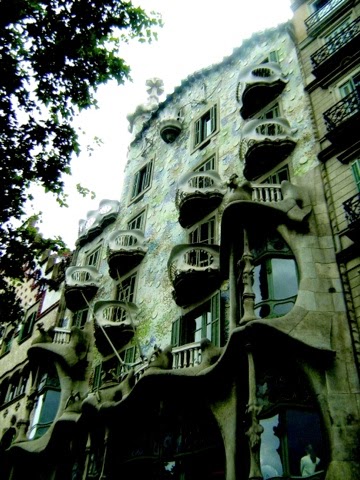Post card from Barcelona: Inside La Pedrera
It was around nine in the evening, when the sun has just set in this part of the world celebrating the onset of summer, when I arrived in Barcelona.
I can still remember that it was nine, as I've missed the paella party organized by the hostel that I booked for my four-day sojourn to the capital of Spain's Catalunya region.
After a short plane ride from Rome's Ciampino Airport, a two-hour bus ride from Gerona, and two Metro rides, I made it to what seemed to me the heart of Barcelona.
It was quite a welcome for me, not because I discovered that my wallet was missing (did I lose it in Rome or just here?), but more because of the colorfully lit, odd-looking building that revealed itself after I emerged from the Passeig de Gràcia station of the Barcelona Metro.
I later on confirmed that this structure is the Casa Batlló, that is without a doubt, one of the many works of the great Antoni Gaudi that littered the city. And great works at that.
This is a must visit, I told myself, as I came to Barcelona not for the parties, not for the shopping, not for the paella (oh come on, I was still headed to Madrid, Granada, and Cordoba so definitely I'll have some other chances to sample the Spanish fare), but more because of the modern art and architecture.
But fate has it that while Casa Batlló is the one closest to my hostel, I met Gaudí -- quite up close and personal -- in another popular work of his: Casa Milà also known as La Pedrera (the quarry, as it looked like one during construction).
Built between 1905-1912, La Pedrera is Gaudí's last civil work specifically for businessman Pere Milà i Camps and his wealthy wife Roser Segimon i Artells.
The building was in a way intended to make Milà a standout among the well-heeled in Barcelona. And a standout he became considering how the design of the structure imposed itself upon the city: not your usul box-type edificio but a building that looks like an open pit quarry with unusual curvy facade, ornate wrought iron balconies, and chimneys with mosaic tiles that are considerably works of art by themselves.
The courtyard is picture-perfect (sans the hordes of tourists, har har) with its uneven walls and interiors that is typically Gaudí -- asymmetrical, colorful, wavy/curvy.
A visit to La Pedrera -- particularly on the floor where the flat of the Milàs was as well as the apartments on the upper floors -- would give one a glimpse at how the bourgeois lived in the mid-1900s as evidenced on the kind of furniture and other belongings on display.
Then at the attic is where an exhibition shows the basics of Gaudì's aesthetics. This is where I learned that aside from religious themes and modernism, his choice of nature as his inspiration best explains what a Gaudì structure is all about, which is not simply avant garde or moderne, if not odd to the uninitiated. Here I found honeycombs that served as inspiration for peepholes, ferns or dried leaves for door knobs and handles, tree trunks for pillars, canopy of leaves for ceilings and naves, and even human bones for various building elements.
 |
| Casa Batllo in Barcelona. Notice how the pillars resemble human bones. The balconies look like pelvic bones, don't you think? |
The rooftop will pass as a theme park on its own, with chimneys decorated with tiles and sculpted as works of art, making it hard to believe that this was where building residents' used to hang their clothes to dry.
 |
| The chimneys at the rooftop of Casa Mila or La Pedrera. These are not merely chimneys but works of art! |
The verdict? Casa Mila is a must in your itinerary to Barcelona. A visit to Barcelona is not complete without the photo ops at the rooftop of Casa Mila. A visit to Barcelona is not complete without knowing Gaudi through this one important work of his. La Pedrera, after all, will not be declared a Unesco World Heritage Site for nothing.
Tip sheet:
- Entrance to La Pedrera costs €20 for adults.
- La Pedrera is accessible through Diagonal station of the Metro.



Comments